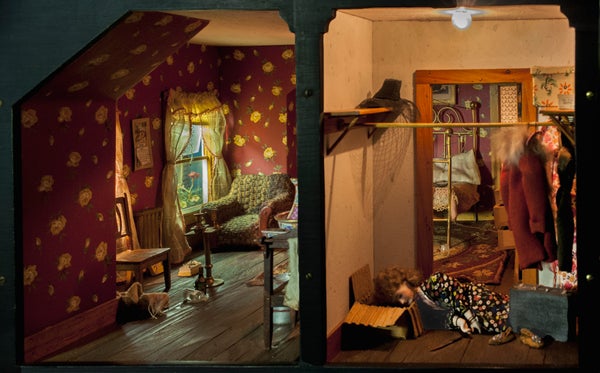This article was published in Scientific American’s former blog network and reflects the views of the author, not necessarily those of Scientific American
They were your typical nuclear family in many ways, at rest before daybreak. Baby in her crib, Mother in the marriage bed, Father—perhaps in the doghouse?—lying alone on a blanket splayed on the master bedroom floor. With onme important difference from most family bedrooms scenes: the trio laid in pools of their own blood, apparently dead from shotgun wounds. Bizarrely, the scene was created inside a child’s dollhouse, oozing with grandmotherly detail and care. The miniature dolls wore hand-stitched clothing, down to their underwear. The creator used her own solid gold egg-beater bracelet-charm—dipped in cheap silver paint for verisimilitude—as one of the cooking utensils displayed on the kitchen counter.
On Wednesday, November 15th, Renwick Gallery curator Nora Atkinson showed Stephen Macknik and me this scene during a tour of the new exhibition of Frances Glessner Lee’s “Nutshell Studies of Unexplained Death” in DC.
Lee, considered the mother of forensic science, was the first woman to obtain the rank of police captain in the US. A talented artist as well as a criminologist, Lee created exquisite dioramas of crime scenes to teach prospective investigators how to properly canvas a scene and collect forensic evidence.
On supporting science journalism
If you're enjoying this article, consider supporting our award-winning journalism by subscribing. By purchasing a subscription you are helping to ensure the future of impactful stories about the discoveries and ideas shaping our world today.
Lee put her considerable talent in traditionally feminine crafts, such as knitting and embroidery, to the service of developing the nascent science of criminology. The artist was famously fastidious in her efforts, knitting tiny doll stockings with straight pins, and painstakingly painting blood spatter with what might have been crimson nail polish. The daintiness of her dollhouse decorations does not take away from the gruesome violence of each tableau, but somehow enhances it.
Lee endeavored to train investigators to “convict the guilty, clear the innocent, and find the truth in a nutshell.” Her “dollhouses of death”–as described by Stephanie Stebich, The Margaret and Terry Stent Director of the Smithsonian Art Museum—are still in use as training tools today. For this reason, the solutions to the cases are not part of the exhibit. Yet, the lack of resolution to the forensic puzzles does not detract from their ability to provide an immersive experience for the audience.
Lee’s remarkable attention to detail helps the viewers’ visual systems fill in the gaps and apply the same degree of scrutiny as they would with life-size objects. The fundamental ambiguity between size and distance in our everyday vision helps suspend the visitors’ disbelief as they canvass each scene in their imaginations. Because all objects project larger images on our retinas as we move closer to them, we can examine Lee’s tiny domestic scenes, up close, in much the same way as we would their equivalents in real life.
Lee’s meticulousness also highlights the limitations of our attentional systems as we search the world around us. Each of Lee’s tiny rooms contains a great deal of information to absorb, so that it is literally impossible to do it in a few glances. One could easily spend an hour scrutinizing each of the 19 montages in the exhibit, and still miss many important clues. Much as we do as we navigate our habitual environments.
“Murder Is Her Hobby” will be on view at the Smithsonian American Art Museum’s Renwick Gallery through January 28, 2018.
